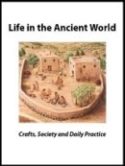For thousands of years, copper was one of the ancient world’s most important minerals. First produced at scale in the Chalcolithic period (which literally means “copper-stone” age, c. 4500–3300 BCE), copper was widely used throughout the Near East and Mediterranean, despite being easily mined at only a few sites, such as Timna and Faynan, both located in the Aravah Valley south of the Dead Sea. But how exactly did the region’s prehistoric people take this innocuous stone and turn it into such an important resource? That is the question archaeologists with the Central Timna Valley Project (CTV) seek to answer through their annual experiments to recreate ancient copper smelting. We joined them to learn about this Chalcolithic secret for ourselves.
Mining and Beneficiation of Ore
Although CTV’s experiments don’t tackle how the copper was mined, decades of excavations at Timna and other sites have revealed extensive mining works from various periods that utilized many different techniques. These included “open pit” and “shaft and gallery” mining (see above image), both of which were used in the Chalcolithic period.

A chunk of copper ore with a clear vein of green copper. Courtesy Nathan Steinmeyer, Biblical Archaeology Society.
While copper can theoretically be smelted immediately after it is mined, the ore often needs to be sorted through beneficiation, the process of weeding out unwanted rock and other debris. In the Chalcolithic, this was done through crushing and sorting the material. This allowed miners to choose chunks of ore with the highest concentrations of copper, which could be easily differentiated from the surrounding stone because of its green color (see above image). During the Chalcolithic period, the ore was likely self-fluxing, containing high amounts of iron oxides, which would react during the heating process to leach unwanted elements away from the copper.

Building the Furnace
To start smelting, it is first necessary to build the furnace. From archaeological finds and previous experiments, the CTV team suggests that during the Chalcolithic period this would have been a shallow furnace dug into the ground, with a diameter of around 15 inches. The limited space concentrates the heat, allowing it to get much hotter without using a large amount of fuel. After this, the furnace is lined with clay and fired to provide additional insulation.
Next, charcoal is added as the fuel source. Charcoal is used instead of wood, as even dried wood contains oxygen that would react with the copper, keeping it from purifying. The type of charcoal used is very important for generating the required heat, while charcoal size can also affect the reaction. At times, harvesting wood for the smelting process was so intense that it could have long-term effects on the local environment. Such was the case at Timna where the effects of harvesting in the Iron Age (c. 1200–586 BCE) can still be seen today.

Recreated sack bellows from the Chalcolithic period, made from leather and wood. Courtesy Nathan Steinmeyer, Biblical Archaeology Society.
Once the charcoal is lit, bellows are used to bring the furnace up to temperature as quickly as possible and keep it there. With the necessary temperature for the ore to melt at around 2000 degrees Fahrenheit, the bellows workers would need to be both highly skilled and fit. It is thought that several bellows were used simultaneously. While the exact style of bellows used in the Chalcolithic remains unknown, the CTV team proposes that it was likely a form of sack bellows (see image above). Although it had previously been assumed that a form of blowpipe may have been used, past experiments have shown this to be a highly inefficient technique.

The various colors of the smelting furnace’s flames. Courtesy Nathan Steinmeyer, Biblical Archaeology Society.
As soon as an appropriate furnace temperature is reached, the copper ore is added, and more coal is placed on top. Ideally, the chunks of ore are quite small, if not powdered, to increase the surface area and speed up the reaction process. As the copper ore reaches the correct temperature, it begins to melt and separate, forming pure copper but also chunks of slag, the byproduct of the process. As this occurs, the furnace’s fire changes color (see image above), as various elements in the ore are vaporized.
Once a large enough percentage of the ore has been smelted, the bellows stop and the furnace begins to cool, the pure copper and slag solidifying. After it is cooled, the furnace is broken up and the material is retrieved (see image above). From here, the CTV team simply broke up the congealed material, separating the solid copper from the slag (see image below).
This pure copper can then be worked into ingots for trade or even worked on-site to craft statues, weapons, and much more. Some of the most remarkable copper items from the Chalcolithic period were found in a cave above the Nahal Mishmar on the western shore of the Dead Sea. The hoard of treasures included mace heads, scepters, and other intriguing items that may have been used in religious or ceremonial rituals.

The Nahal Mishmar Hoard. Hanay, CC BY-SA 3.0, via Wikimedia Commons.
Read more in Bible History Daily:
All-Access members, read more in the BAS Library:
Not a BAS Library or All-Access Member yet? Join today.The post How to Smelt Chalcolithic Copper first appeared on Biblical Archaeology Society.
The post How to Smelt Chalcolithic Copper appeared first on Biblical Archaeology Society.






0 Commentaires